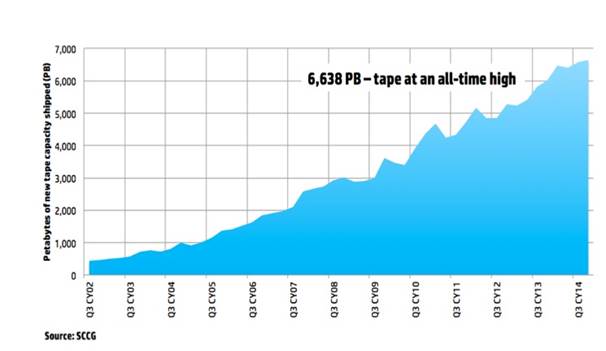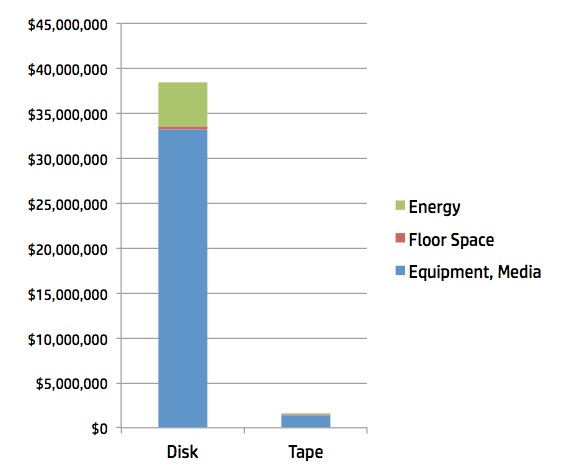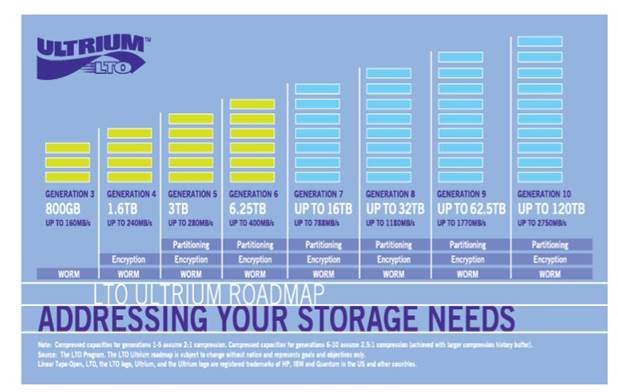 In this special guest feature, Simon Watkins of HP Storage gives his perspectives on how LTO tape offers important storage opportunities in the era of Big Data and Cloud. Simon Watkins is Worldwide Product Marketing Manger, Backup, Recovery & Archive (BURA) for HP Storage.
In this special guest feature, Simon Watkins of HP Storage gives his perspectives on how LTO tape offers important storage opportunities in the era of Big Data and Cloud. Simon Watkins is Worldwide Product Marketing Manger, Backup, Recovery & Archive (BURA) for HP Storage.
The LTO (Linear Tape-Open) tape market reached two significant milestones this month. LTO-6 tape media pricing fell below one cent per gigabyte and total worldwide tape storage media capacity shipped reached record levels. These two announcements are intrinsically linked—and a key driver for why more data is being stored on tape than ever before is LTO’s powerful blend of cost-effectiveness as well as scalability, reliability and portability.
How can LTO tape help manage the Big Data explosion?
As evidenced by these two milestones, even as the role of tape has shifted over the years, LTO tape has remained a critical component for the modern data centre. For example, Big Data archive has emerged as a key usage model for tape, fueled by data growth, unprecedented cartridge capacity increases, longer media life, improved bit error rates and a growing ecosystem of Linear Tape File System (LTFS) based solutions. This makes a lot of sense, as LTO tape continues to offer the lowest cost solution for long-term data retention and reliable retrieval, making it ideal media for Big Data archives.
Our customers understand the value of LTO tape for archive—particularly in the context of growing regulatory requirements to maintain access to data “forever.” Not to mention the demand for Big Data to be retained, analyzed and monetized. A recent research study from Enterprise Strategy Group (ESG) concluded that 82% of of tape-using respondents surveyed anticipated either maintaining or increasing their organization’s use of tape for long-term retention.
LTO tape’s archive use case is resonating with customers and partners across all major industries around the world. We are seeing particularly strong traction in data-intensive markets such as media and entertainment, scientific research, oil and gas exploration, surveillance, cloud and HPC.
As an example, DreamWorks Animation recently implemented an active archive solution to safeguard a 2-petabyte portfolio of video animation assets, supporting a long-term asset preservation strategy. The studio’s comprehensive, tiered converged active archive architecture—which spans software, disk and tape—saves the company time and money while reducing risk. DreamWorks estimates that the implementation of tape saves between 15 and 20 kilowatts per hour for each petabyte of spinning disk.
Will Google Nearline and Amazon Glacier cast a cloud over tape for big data archives?
Cloud based archive services such as Google Nearline and Amazon Glacier are designed for smaller data sets in “cold” archives where retrieval requirements are minimal to zero. The bandwidth and retrieval costs of these services mean that they are simply not practical for markets such as media and entertainment and high performance computing, where multi-petabyte active archives are commonplace and where data is indexed and accessed frequently. Hence, the economics of cloud-based verses on-premise are highly dependent upon your particular storage and access requirements. No one size fits all!
LTO—paving the road to the future
5 million LTO tape drives and over 250 million LTO tape cartridges have shipped since LTO-1 solutions were first introduced to the market in 2000. This equates to over 100,000 PB of data protected and retained using LTO technology and over 100 million miles of LTO tape media shipped since launch. That’s more than the distance of the sun from the earth!
A key driver for LTO’s phenomenal market success is the fact it was developed by a consortium of LTO technology provider companies—including HP as a founding member—to provide an open tape format standard with multiple vendors bringing LTO based products to market to meet the need for reliable, high capacity, high performance data protection in a small footprint.
Prior to LTO’s introduction, the tape market was characterised by proprietary tape formats, creating issues around interoperability, roadmap credibility and product availability. By contrast LTO is as an open format licensed across the storage industry to ensure broad compatibility.
The LTO technology roadmap has recently expanded to 10 generations. The proposed capacities and transfer rates are breathtaking. Gen 10 capacities are targeted to reach 120TB compressed in a single cartridge, which is the equivalent capacity of 600 generation 1 LTO cartridges! In addition to the huge capacity leaps, transfer rates are expected to reach a staggering 2,750 MB/sec (2.75GB/s) compressed. In contrast generation 1 of LTO was 40MB/sec. Each new generation includes read-and-write backwards compatibility with the prior generation as well as read compatibility with cartridges from two generations prior to protect investments and ease tape conversion and implementation.
This shows the great and consistent advances and innovation steps that LTO Technology has delivered over the last decade including features such as WORM technology, encryption and LTFS.
Driving efficiency and innovation through closer collaboration
Delivering on the LTO roadmap requires supply chain, partner and customer application synergies, as is the case with many other mature industries. This can best be delivered by closer vendor collaboration and alignment in areas such as drive mechanism development.
HP is committed to deepening our collaboration with IBM in in the development of future generations of LTO technologies, beginning with the forthcoming LTO-7. We remain focussed on developing the market-leading HP StoreEver tape portfolio and will continue to invest in the new use cases and ecosystems that take advantage of the cost and durability of LTO-based storage.
Learn more about HP StoreEver.
Sign up for the free insideBIGDATA newsletter.







Speak Your Mind